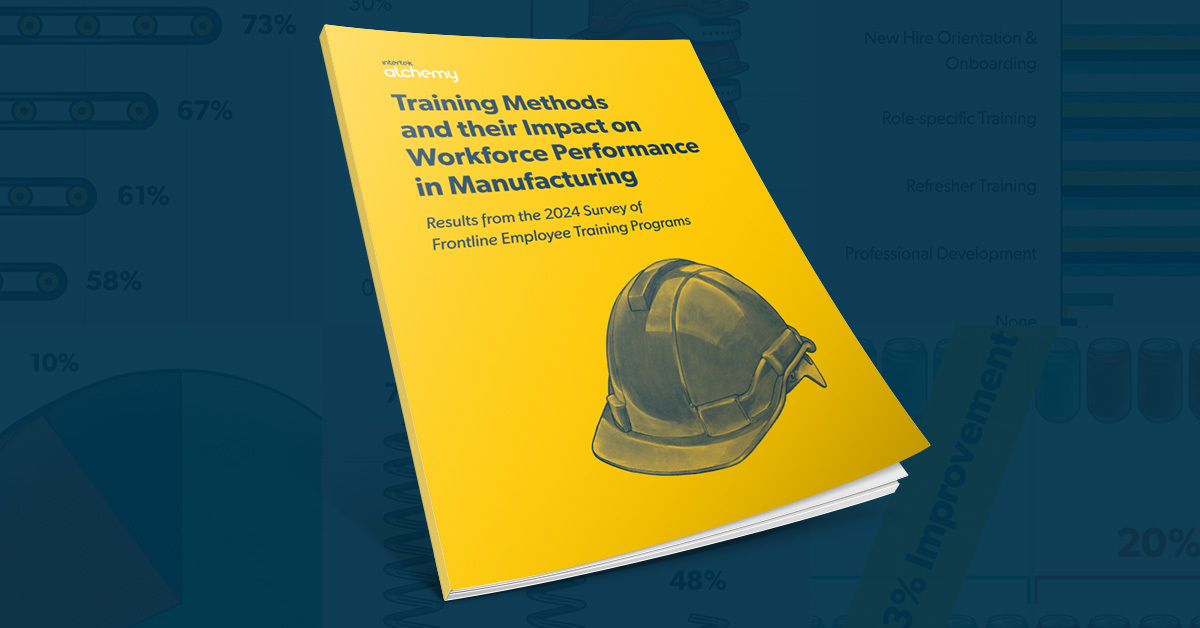The What, Why, When, and How of a Strong Training Reinforcement Program

Across the board, organizations invest substantial resources to enhance employee performance and skills. Much of the effort focuses on the initial onboarding training — sometimes disproportionately so. After all, ensuring that the learning sticks and translates into sustained performance improvement goes beyond onboarding. This is where the power of training reinforcement comes into play.
The recent research study, “Training Methods and their Impact on Workforce Performance in Manufacturing,” found a number of training best practices that lead to greater performance and safety. It was revealed that having a strong training reinforcement program creates the largest overall increase in workforce performance across multiple desired outcomes, including:
- 215% improvement in employees consistently applying established SOPs on the floor,
- 58% lift in employee ability to proactively spot and prevent a safety risk or quality defect,
- 85% increase in accuracy of worker-to-worker instruction – preventing the spread of bad habits,
- 87% increase in employee motivation.
With results like that, it’s clear that through proper training reinforcement practices, companies can bridge the gap between knowledge acquisition and practical application, ensuring that employees not only retain what they’ve learned but also integrate it into their daily work routines with ease. In this blog, we will explore the critical role of training reinforcement in driving long-term success and provide strategies to implement an effective reinforcement program that yields measurable results.
The Components of a Solid Training Reinforcement Program
Now that we understand the importance of having a strong training reinforcement program, it begs the question: what exactly does a good program look like? Let’s dive into that!
A solid training reinforcement program is built on several key components. The first component is spaced repetition, which involves revisiting the training material at regular intervals. This technique leverages the spacing effect, a psychological phenomenon where information is better remembered if it is reviewed over spaced intervals rather than crammed in a short period. Incorporating spaced repetition into the reinforcement strategy enhances retention and understanding over time.
Of course, no amount of training will suffice if the content was misunderstood or is mis-applied. Which is why on-the-floor validation is an absolute must for your program. Apply a cadence to observing employees applying their training on the floor. Make these coaching moments, not disciplinary moments. Supervisors should be prepared to provide any coaching or correcting needed if an employee doesn’t perform according to their training. Everything should be documented, and if certain procedures or practices are often mis-applied, it’s a good idea to revisit the original training material as revisions may be in order.
While this direct, active engagement is essential, you should also incorporate several passive reinforcement elements into your program. Some examples of passive reinforcement are posters and bulletin boards in high traffic areas, and looping videos in break rooms. Having these physical reminders in the workplace can inspire better muscle memory and improve knowledge retention amongst your workers. If you see something every day, you’re more likely to do the right thing.
To summarize, a strong training reinforcement program will include:
- Spaced repetition, or refreshers, of initial training,
- On-the-floor observations to validate correct application,
- Active coaching and training reinforcement by floor supervisors,
- Passive, always-on visual reminders like posters, digital signs, etc.
By integrating these key components, organizations can create a robust training reinforcement program that drives long-term success and employee development. So, let’s dissect these elements further for successful implementation on the manufacturing floor.
How to Implement the Key Components
Spaced repetition is where you should start. The best way to implement this is by incorporating shorter refresher courses with direct connection to concepts that were presented in initial training. Using a high-quality learning management system (LMS) to administer the training simplifies this process tremendously. For example, the Alchemy Training System makes it easy to establish learning plans with refresher training pre-built into the program, complete with automated reminders when refresher training is coming up or past due.
You will need your LMS to extend to the factory floor in order to succeed at our need for observations and validation. This is where mobile training tools like Alchemy Coach become your supervisors’ best friend. After all, not every supervisor is a natural born trainer or coach, but they can be with this technology in their hands. The app will show supervisors which employees they need to observe for which training activities – and provide the step-by-step process to do so. Even better, any corrective actions are also pre-baked, giving the supervisor a script to follow, complete with digital sign-off when complete.
Peer collaboration and communication is also a great way to implement reinforcement training. Encouraging employees to share insights and discuss concepts with their peers fosters a collaborative learning environment where knowledge is continuously exchanged and reinforced. When knowledge is shared continuously, it is being reinforced with very little effort from management.
Make sure you’re providing continuous feedback to achieve your goals. Regular feedback helps employees understand their progress, identify areas for improvement, and stay motivated to achieve their learning goals. Check-in with your team regularly for the best results. Implementing feedback ensures that your reinforcement training is hitting all of your objectives and meeting the needs of your employees.
Creating a Lasting Impact
If you want your employees to perform their best, then you must give them ample opportunities to grow in their skillset. People are more comfortable when they are confident in their actions, which is the outcome of strong training reinforcement. Consistent reinforcement also creates consistent interaction and communication between frontline workers and their supervisors and managers. This engagement impacts motivation positively across the board.
All in all, the effectiveness of any training program hinges not just on the initial onboarding experience but on the strategies employed to reinforce that training. A well-structured training reinforcement program transforms knowledge retention into practical application, fostering a culture of continuous improvement and skill development. This approach not only enhances individual performance but also drives organizational success, positioning companies to thrive and prosper.





